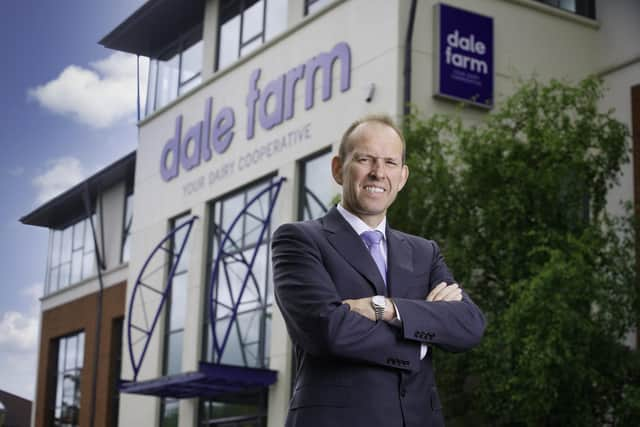Dale Farm targets 2.5% growth in milk pool
and live on Freeview channel 276
But according to the co-op’s Group CEO, Nick Whelan, this level of performance must be achieved on a “wholly sustainable” basis.
“Every business must be allowed to grow, if it is to have a viable future. Dairy farmers and processors are no different in this regard,” he said.
Advertisement
Advertisement
Whelan foresees growth in farm milk output being a driver for the envisaged expansion of Dale Farm’s processing operation.


“But we must earn the right to make this happen. And this means only one thing: producing milk on a more sustainable and efficient basis.”
Whelan is very mindful of the fact that agriculture in Northern Ireland must respond to the targets set out in the Stormont Climate Change Bill, agreed earlier this year.
“We are talking about an overall 30% reduction in emission levels by 2030. The time for talking has stopped: we need action,” he commented.
Advertisement
Advertisement
The Dale Farm representative has welcomed the moves afoot to establish an industry-led sustainability group, representing all the sectors that constitute production agriculture in Northern Ireland.
He added:“I am glad to see the Ulster Farmers’ Union taking such a prominent role in this initiative. But the bottom line is that real action on emission reductions must be agreed during 2023.”
In practical terms, Whelan sees two developments taking place at farm level that will make a real difference as agriculture responds to the challenge of climate change.
Step one will see farmers securing the actual carbon footprint value of their businesses.
Advertisement
Advertisement
“But we have got to move on from that in very short order. And this will require each farm business establishing its own sustainability plan for the future,” he stressed.
“In the case of Dale Farm we will be working with all individual farmer-suppliers to make this happen.
“But nobody should be under estimating the scale of the challenge ahead.
Turn to page 3
Local dairy farmers have managed to reduce the carbon footprint of their milk output by around 30% in as many years.
Advertisement
Advertisement
“Looking ahead, they have to go down the same road again. But this time they have only seven years to meet the new target.”
Reflecting on the last 12 months, Nick Whelan characterised 2022 as a “strong year” for dairy farmers in Northern Ireland, despite inflationary pressures and in some cases fixed milk price hardship.
“Yes, input costs have gone up by the equivalent of 10 - 12p/L over the past 12 months,” he added.
“Milk prices have increased by 16p in the same period. Our customers have continued to work with us. They recognised the inflationary pressures coming on to our production and processing systems. They have supported our farmers and responded accordingly. ”
Advertisement
Advertisement
However, there are a number of indicators pointing to challenges coming down the track for the milk sector.
Chief among these is the continuing lack of growth within China’s economy.
“This is impacting on global demand for dairy products,” Whelan further explained.
“Coming closer to home, we are now seeing the dairy industries in France, Germany, Holland and the UK responding to better prices.
Advertisement
Advertisement
“Back in the spring, milk volumes in these counties were falling: now they are increasing. At the end of the day, milk markets are driven by supply and demand.”
According to the Dale Farm CEO, the producer price now available in Northern Ireland is well above what the market can actually offer.
He added:“Dairy markets can be extremely fickle at this time of the year with many suppliers clearing stocks to generate cash for their year-end, but the current weakness is more than this.”
Dale Farm paid a leading milk price of a base price of just over 47p/L for October milk, which was added-to by the 2p/L winter bonus.
Advertisement
Advertisement
“It’s unlikely that farm gate prices will change before the end of the calendar year,” Nick Whelan concluded.
“We will have to wait until January to see how dairy markets settle down. There may be some relief in input costs reducing on farm with oil and gas prices easing of late, but supply and demand in global dairy is putting significant pressure on milk price.”